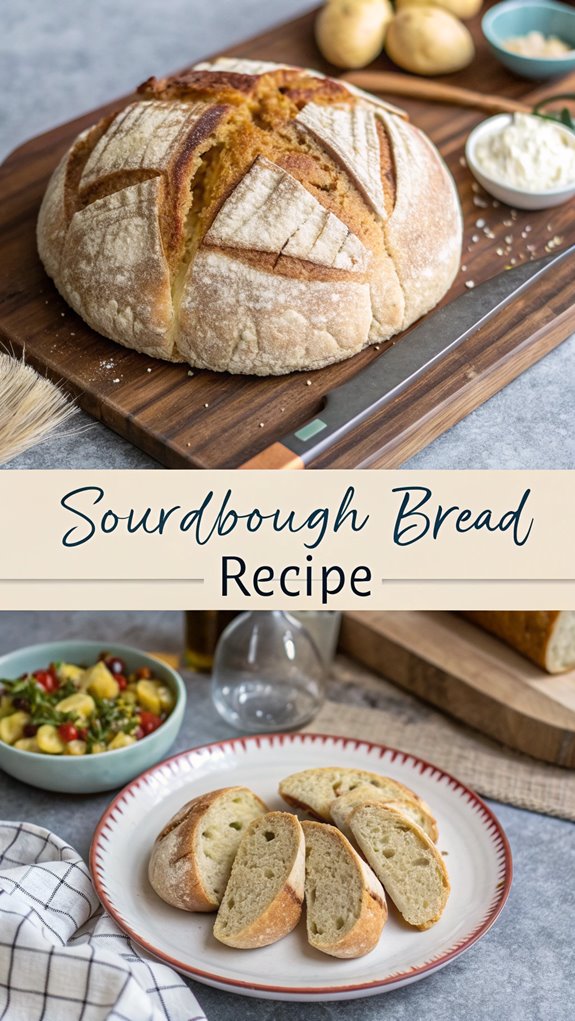4 ingredient sourdough bread
4 Ingredient Sourdough Bread
Making 4 Ingredient Sourdough Bread is a straightforward process that anyone can master. All you need is flour, water, salt, and a sourdough starter. You’ll mix these ingredients to create a dough, let it rise, and then bake it. This method showcases the magic of natural fermentation, leading to a tasty loaf. If you’re curious about how this simple recipe has a rich history and what you can expect from the final product, keep going.
Why You’ll Love This Recipe
When you try this sourdough bread recipe, you’ll discover a world of benefits that make it a standout choice for your diet.
Sourdough is rich in antioxidants, which may lower your risk of chronic diseases and signs of aging. Its lower glycemic index helps keep your blood sugar stable, unlike white bread. Additionally, the lactic acid bacteria present in sourdough enhance the availability of essential nutrients like folate and magnesium.
The slow fermentation process breaks down gluten, making it easier to digest while also enhancing nutrient absorption. You’ll find that sourdough is high in essential vitamins and minerals like folate and magnesium.
With a higher fiber content, it supports gut health and can help you feel fuller longer. Overall, sourdough offers a delicious way to incorporate nutritious ingredients into your meals.
History
Sourdough bread has a fascinating history that dates back thousands of years, originating in ancient Egypt around 3700 BCE.
It’s one of the oldest forms of leavened bread, created when a mixture of flour and water was left out, allowing wild yeast and bacteria to ferment. This bread became a staple in ancient Egypt and spread to cultures like Greece and Rome, where it was even used in religious ceremonies. Sourdough remained a primary bread-making method until the Middle Ages when it was replaced by other leavening techniques. During the California Gold Rush, sourdough became essential for miners, who protected their starters like treasure. Natural starters are a key element of sourdough that set it apart from other breads. Today, sourdough is experiencing a revival among bakers, celebrating its rich history and flavor.
Recipe

Sourdough bread is a delightful and rewarding project that combines the artistry of baking with the science of fermentation. The unique flavor and chewy texture of sourdough are achieved through the natural fermentation process, where wild yeast and bacteria work together to leaven the dough. This recipe will guide you through the steps required to create your own scrumptious sourdough bread, perfect for sandwiches, toast, or simply enjoyed on its own. Sourdough is recognized for its tangy flavor and health benefits from naturally occurring acids.
Before you begin, verify you have a healthy sourdough starter that’s been fed within the last 6-12 hours. This will provide the necessary leavening power for your bread. The process involves mixing, autolyse, kneading, and allowing the dough to rise, followed by baking in a Dutch oven or another suitable method. With some patience and practice, you’ll be able to master this classic artisanal bread.
Ingredients:
- 500g Bread Flour
- 330g Water
- 150g Sourdough Starter
- 10g Salt
- (Optional) 25g Olive Oil
- (Optional) 90g Whole Wheat Flour
Instructions:
- In a large mixing bowl, combine the water and sourdough starter. Stir until well mixed.
- Gradually add the bread flour and salt (and whole wheat flour if using) to the mixture. Stir until no dry flour remains and a shaggy dough forms.
- Allow the dough to rest for 30 minutes to 1 hour in a process called autolyse. This helps with gluten development.
- After the autolyse period, knead the dough by hand or use the stretch and fold technique to work it into a cohesive ball.
- Place the dough in a lightly greased bowl and cover it with a damp cloth or plastic wrap. Let it rise at room temperature until it has doubled in size, which may take several hours depending on the ambient temperature.
- Once the dough has risen, gently deflate it and shape it into a round loaf. Transfer it to a floured proofing basket or bowl, seam side up. Cover it with a cloth and let it rise again for 1-2 hours.
- Preheat your oven to 450°F (230°C) with a Dutch oven inside for at least 30 minutes.
- Carefully remove the hot Dutch oven and place the dough inside. Cover it with the lid and bake for 30 minutes.
- After 30 minutes, remove the lid and bake for an additional 15-20 minutes, or until the bread is golden brown and sounds hollow when tapped on the bottom.
- Allow the bread to cool on a wire rack for at least 1 hour before slicing.
For the best results, remember to weigh your ingredients using a digital scale for accuracy. Additionally, keep an eye on your dough during the rise; environmental factors can affect the fermentation time, so be flexible with your timings.
Finally, don’t rush the cooling process; slicing too early can result in a gummy texture. Enjoy the fruits of your labor and the delightful aroma of freshly baked sourdough!
Final Thoughts
As you finish your sourdough baking journey, it’s important to reflect on the process and the delightful bread you’ve created.
You’ve not only made a delicious loaf but also embraced numerous health benefits. Sourdough bread is easier to digest and helps stabilize blood sugar levels. The use of wholemeal flour enhances its nutritional value and promotes better mineral absorption. Additionally, incorporating high hydration dough can lead to a lighter and airier crumb in your bread.
Remember, proper storage is key to maintaining freshness; keep your bread in a paper bag and out of direct sunlight. If the crust softens, a quick toast can restore its texture.
Enjoy the satisfaction of your homemade sourdough, and consider experimenting with different ingredients, like herbs or cheese, to elevate your next baking adventure.
Happy baking!
FAQ
Have you ever wondered what makes sourdough bread so unique? One key ingredient is the sourdough starter, which ferments sugars and acts as yeast.
You’ll need to feed it regularly, using a 1:5:5 or 1:8:8 ratio to keep it bubbly and active. The flour you choose is also important; both bread flour and whole wheat can work, but remember to adjust water for whole wheat to avoid a dry dough. Bakers percentages help you understand the ideal hydration levels for your dough, ensuring a successful bake.
Water activates gluten and supports yeast growth, while salt adds flavor and controls yeast activity. Don’t forget optional ingredients like olive oil or herbs for extra flavor!
Using the right tools, like a Dutch oven and proofing basket, can also help you achieve the perfect loaf.

4 Ingredient Sourdough Bread
Ingredients
- Ingredients:
- 500 g Bread Flour
- 330 g Water
- 150 g Sourdough Starter
- 10 g Salt
- Optional 25g Olive Oil
- Optional 90g Whole Wheat Flour
Instructions
- Instructions:
- In a large mixing bowl, combine the water and sourdough starter. Stir until well mixed.
- Gradually add the bread flour and salt (and whole wheat flour if using) to the mixture. Stir until no dry flour remains and a shaggy dough forms.
- Allow the dough to rest for 30 minutes to 1 hour in a process called autolyse. This helps with gluten development.
- After the autolyse period, knead the dough by hand or use the stretch and fold technique to work it into a cohesive ball.
- Place the dough in a lightly greased bowl and cover it with a damp cloth or plastic wrap. Let it rise at room temperature until it has doubled in size, which may take several hours depending on the ambient temperature.
- Once the dough has risen, gently deflate it and shape it into a round loaf. Transfer it to a floured proofing basket or bowl, seam side up. Cover it with a cloth and let it rise again for 1-2 hours.
- Preheat your oven to 450°F (230°C) with a Dutch oven inside for at least 30 minutes.
- Carefully remove the hot Dutch oven and place the dough inside. Cover it with the lid and bake for 30 minutes.
- After 30 minutes, remove the lid and bake for an additional 15-20 minutes, or until the bread is golden brown and sounds hollow when tapped on the bottom.
- Allow the bread to cool on a wire rack for at least 1 hour before slicing.
- For the best results, remember to weigh your ingredients using a digital scale for accuracy. Additionally, keep an eye on your dough during the rise; environmental factors can affect the fermentation time, so be flexible with your timings.
- Finally, don't rush the cooling process; slicing too early can result in a gummy texture. Enjoy the fruits of your labor and the delightful aroma of freshly baked sourdough!
- Final Thoughts